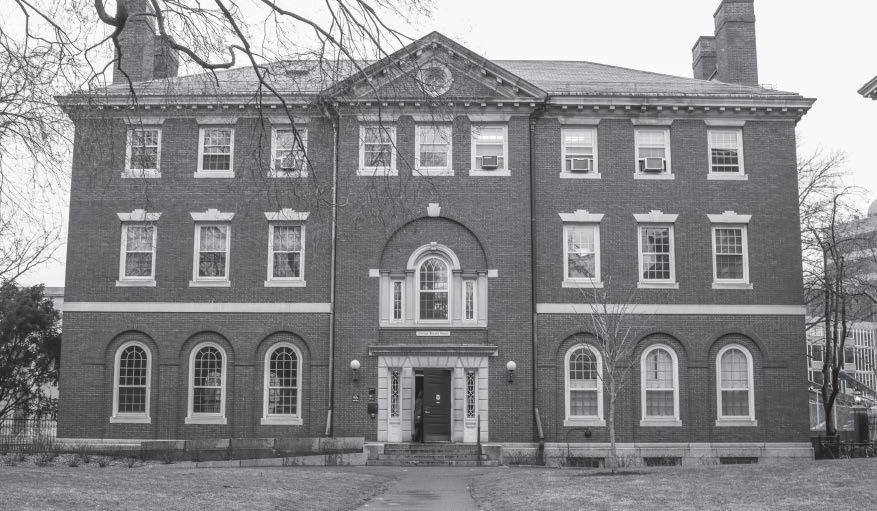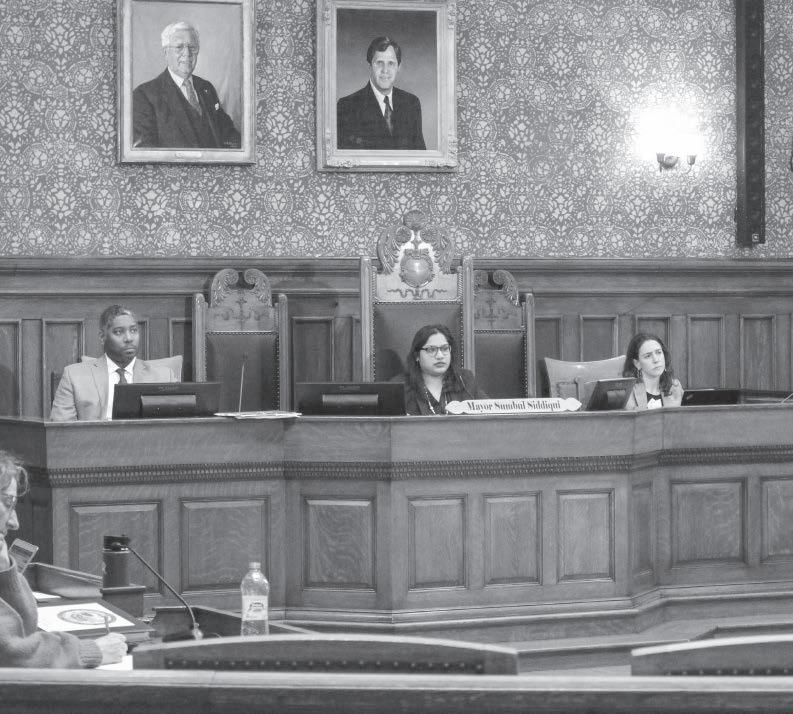
20 minute read
Editorial
The Crimson Edi orial board Who Says Teens Shouldn’t Vote?
As recently as 1971, Harvard students under 21 were still fighting for the right to vote. That proba bly seems absurd now. Which raises the question: In another half-century, will it be equally absurd that 16- and 17-yearolds can’t vote now?
Last week, Cambridge City Coun cil voted in favor of allowing citizens aged 16 and older to vote in Cambridge elections for city council, school com mittee, and local ballot measures. The home rule petition has been forwarded to the Massachusetts State Legislature and requires its approval before 16- and 17-year-olds can, contra Mass. state law, vote in Cambridge elections.
This marks the third time that the Cambridge City Council has proposed lowering the voting age, with the previ ous two in 2002 and 2006 ultimately failing in the state legislature. The difficulty faced by the proposal matches a perva
sive national skepticism about lowering the voting age.
In a recent poll, a majority of regis tered voters opposed lowering the voting age, and when Mass. Representative Ayanna Pressley proposed doing so as part of a voting rights bill, the amend ment failed 126 to 305, with opponents expressing doubts that 16-year-olds had sufficient maturity. It follows that only Takoma Park, Md. has granted 16- and 17-year-olds the municipal right.
While the disenfranchisement of young people is certainly not analogous to this discrimination of people of col or, a lack of maturity seems to be a weak argument that makes apparent a profound historical myopia. Racist limitations on suffrage have historically taken their most insidious forms as poll taxes and literacy tests, which were meant to bar black voters by taking advantage of their reduced economic means and lim ited access to education. It would take the Voting Rights Act of 1965 and the 24th Amendment, ratified in 1964, to le gally abolish these forms of discrimination. As a society, we rightly came to acknowledge that notions of voter quality or qualification are more often than not masks, easy ways to disenfranchise peo ple whose voice is perceived by those in power as a threat.
Our society functions on the principle that individuals should have the right to collectively select their representatives in local, state, and federal governments, holding them accountable through regu lar and frequent elections. Expansion of those rights, therefore, merit serious dis cussions and reflections.
As such, we support granting 16- and 17-year-olds the vote, especially on the local issues that directly affect them, not on grounds of their capacities but on the grounds that it is their right to do so.
Still, we believe that granting young people the right to vote is a great oppor tunity to increase their civic awareness and engagement more broadly. Along side this new civil liberty, Cambridge schools should spend more time teaching civics to help students make informed decisions at the ballot box. We commend the work that the Harvard Civics Pro gram has done in that area.
Moreover, beyond first-principle ar guments, we believe that lowering the voting age in local elections also pro vides practical benefits for local politics. Currently, many people are introduced to politics when they come of age in col lege, and, as a result, most of their attention is likely focused on national issues and their accompanying brouhaha, often at the cost of important local politics. The average local election draws one in every five voters, and 99 percent of re spondents in an average media market never look at local news sites.
If young people were introduced to politics at the local election before leav ing home, they might well come to appreciate and form long-term and mean
ingful engagements with local politics, which many would argue carry more sig nificance and impact than national elections anyway.
Lastly, as we champion the enfran chisement of young voters, we would be remiss if we fail to recognize the many people — noncitizen residents, undocu mented residents, incarcerated citizens, or ex-felons — who do not have the right to vote. Equally, they deserve a say on matters that affect them, and the depri vation of their rights is a stain on our democracy.
This staff editorial solely represents the majority view of The Crimson Editorial Board. It is the product of discussions at regular Editorial Board meetings. In order to ensure the impartiality of our journal ism, Crimson editors who choose to opine and vote at these meetings are not involved in the reporting of articles on similar top ics.
Submit an Op-Ed Today!
The Crimson @thecrimson
The Lowell Legacy Revisited Op-ed
The iconic bell tower of Lowell House looms over the campus, reminding students every day of the greatness of President Abbott Law rence Lowell, Class of 1877. In addition to this tower atop the imposing upperclass man house, hundreds of students flood into Lowell Lecture Hall for class and re hearsals. Evidently, the Lowell legacy is eternalized on this campus, regardless of whether students really know who the man himself was. However, Lowell’s ac tions in the early twentieth century raise questions as to whether he is deserving of the high praise the University bestows upon him to this day.
In 1922, President Lowell recom mended to the Board of Overseers a quoBy A. J. VENEZIANO
ta system to be placed upon Jewish applicants. In the wake of the mass immigration of the 1920s, Lowell evidently was threatened by the premise of a challenge to the historically Christian, Anglo-Sax on tradition of Harvard. Additionally, he denied housing accommodations to mul tiple African American students, claiming that “from the beginning, we have not thought it possible to compel men of different races to reside together.”
Recently, it was discovered that Pres ident Lowell led a cutthroat crusade against gay students in 1920. In what is now referred to as the “Secret Court of 1920,” Lowell and Acting Dean of the College Chester N. Greenough found 14 men “guilty” of partaking in homosexu al acts on campus, including seven College students who were subsequently expelled and asked to leave Cambridge. The main substantial evidence came from the students’ attendance at the lavish parties held by Ernest Roberts in Perkins Hall 28. Following the guilty verdict, two students committed suicide and the rest were left blacklisted from other univer sities. This year is the one-hundredth anniversary of their expulsions.
One could imagine the level of dis comfort for a BGLTQ student, Jewish student, or student of color living in the house of the man who wanted them ban ished from campus. During the recent renovation, the Faculty Deans of Low ell House, David I. Laibson ’88 and Nina Zipser have encouraged removing a bust of Abbott Lawrence Lowell from the courtyard, and the portraits of Lowell and his wife were removed from the din ing hall. The dining hall is a space to foster community among Lowell residents, and the new deans decided that Presi dent Lowell did not belong there. While the portrait of Lowell has left, one can find a portrait of his sister, Amy — a nota ble lesbian, Pulitzer-prize winning poet, hanging there. This seems to be an apt replacement of the openly homophobic president. Furthermore, Lowell House is creating a committee to research Lowell and ponder how to grapple with his com plicated legacy today.
So, should Lowell House be renamed in order to cease honoring Abbott Lawrence Lowell? I believe this is not necessary, since the House represents the entire Lowell dynasty, not just the president from the early twentieth century. As one prepares to leave the House, the bust in the courtyard of James Russell Lowell, an important abolitionist poet from the 1800s, can clearly be seen on its pedestal. Furthermore, the portrait of John Lowell, the Massachusetts law yer who helped draft the 1780 Massachusetts constitution, leading to the abolition of slavery in the state, hangs proudly in the House. To erase their name from the building would be erasing their lega cy as well.
However, an interesting conflict re mains: The University has not taken the same steps to change Lowell’s legacy as Laibson and Zipser have done as deans.
In fact, in the Faculty Room in Univer sity Hall, President Lowell is one of few individuals to be memorialized twice — in a painting and a bust. Interesting ly enough, the bust was sculpted by John Wilson, the artist responsible for the “Silent Sam” statue that led to immense controversy at the University of North Carolina.
Henceforth, I call upon the Harvard administration to follow in the steps of the Lowell House deans and halt the ex cessive memorialization of Abbott Lawrence Lowell. Ceasing to memorialize a figure is not the same as erasure; tak ing this step simply says that this figure is not worthy of our adoration. As a queer student, it frustrates me to know that the Faculty Room has a proud bust of the man who would have abhorred my presence in the Yard. Removing the bust — if not the painting as well — is a neces sary start to atoning for a shameful part of this institution’s history.
Until then, the Lowell bell tower will continue to chime as time passes while the individuals Lowell destroyed are for gotten.
The Conservative Case for Divestment Protest olumn Eric Yang pl truth
The timeless tension in politics, that liberals think conservatives are evil, and conservatives think liberals are stupid, manifests itself once again in the current debate over divestment and the merits of protest. Between the clamors for climate justice and the complete condemnation of divestment’s goals and meth ods, I believe it is important to articulate a moderate position that attempts to clarify some of the underlying logic of both sides and work to bridge this disagreement.
To have a contained discussion of divestment protest, here are three assumptions that I take for granted: firstly, that global warming is a se rious issue that warrants immediate, thoughtful action; secondly, that divestment is one of many means for the University to address this issue; fi nally, that there are better means for the University to address this issue.
I omit any discussion of my thoughts on the fi nal assumption, the major source of contention on campus, precisely because it is so over discussed. It is my view that this emphasis on divestment misses a key point about divestment protest, and one of its greatest merits — that it is not just an ar gument about the merits of divestment, but a clarion call for climate action in general. I am against divestment, but for divestment protest.
The disruption caused by divestment protest is an essential part of this greater argument for ac tion. The disruptive nature of the divestment protest invites comparison to other disruptive protests and debates over their moral equivalency. Why isn’t the divestment protest like the Vietnam protest or the divest South Africa movement? The moral argument implied by disruptive protest is not only the scapegoating of an authority figure, as some might argue, but more importantly, a gen eral indictment of the complicity of the greater community for perpetuating the status quo. The sin of the greater Harvard student community is not the commissioning of funds for investment, but the sin of inaction.
President Bacow’s call for the protesters to utilize the proper and less disruptive channels of influence misses the effectiveness and signifi cance of this moral argument respectively. On the first point, while institutions can effect change in gradual, systematic ways, they also have every ability to thwart change in a gradual, systematic manner. President Bacow can organize any num ber of proper committee meetings, faculty votes, and community-based discussions that result in the continuation of the status quo.
This capacity for delayed change, however, is not the fault of institutions as a whole, but the very strength of their design. Harvard cannot, and should not, immediately implement the next good idea that comes along, no matter how many undergraduates support it. This is because insti tutions are not independent, or even democratic, actors that can choose to “do the right thing,” but complex multi-headed systems with defined lines of accountability and express limitations on what they can do. Intractable, “evil” institutions make effecting change more difficult, but reversing it even harder, and thus help to create the ideolog ical consistency necessary for lasting, structural change.
However, it is precisely because of their gen eral tendency towards inaction and the maintenance of the status quo’s rate of progression that on important issues which require immediate ac tion, like global warming, decisive pushing is necessary to reorient institutions towards the correct path. Divestment protest has shifted the discourse in Harvard to center around concerns of global warming; so much so that the president of the Harvard Republican Club has publicly ad vocated his own solutions to the environmental crisis. The effect of discourse shifting and con science raising is not an abstract intellectual accomplishment. While President Bacow is right to say that there are other, better ways of saving the planet, his claim indicates that the protest ers have successfully asserted the importance of their call for action.
A strong call to action is necessary to effect even the most moderate, reasonable change be cause as conservatives know, the institutional reluctance to “do the right thing” applies to its calculus of economic cents, common sense, and moral obligation. Despite the obvious appeal and almost universal support among economists for ideas like carbon dividends, Congress has still yet to implement them, in part because none of the respectable economists who endorse carbon dividends will disrupt a presidential address to demonstrate their support for them. The “dumb” liberals, nay the “dumbest” liberals, have often played an instrumental, if underappreciated role in creating the moderate, positive social change that most people desire.
The conservatism that I advocate for — the conservatism that supports divestment protest, but not divestment — is rooted in a deep skepti cism of the most intractable institutions as well as the best of intentions. The universe will bend itself towards justice, but it shouldn’t bend with the exact curvature and rate that the divestment protestors want it to.
Student-Athletes Provide Input on AD Search SEARCH From Page 1
with the search advisory committee’s chair and former Faculty of Arts and Sciences Dean Michael D. Smith and commit tee members Dean of Students Katherine G. O’Dair and Gwill E. York ’79, the former Vice Chair of the Harvard Board of Overseers, according to SAAC Co-President Matt R. Thomas ’21, who attended the meeting. Thomas said the group of athletes who attended said they hope the next Athletics Direc tor will monitor the “pulse of the student body.”
“I think one thing we’ve re ally liked in Bob was his openness and communication and availability to students,” Thom as said.
He added that he hopes Scal ise’s successor will be receptive to student concerns, pinpoint ing athletes’ concerns regarding scheduling conflicts and food inaccessibility.
Matt R. Thomas ’21 SAA C Co-President
SAAC member Sam B. Scherl ’21, who also attended the meet ing, said he spoke about the importance of pride in Harvard athletics at the meeting.
“Harvard should have the same level of pride it would in its athletic teams and the athletic director should have that same level pride in athletic teams as they would with the speech and debate team and the orchestra,” he said.
Other athletes said they shared Scherl’s belief that the forthcoming Athletics Director should emphasize excellence in non-academic pursuits.
Mimi F. Tarrant ’21 said her top priority in the forthcoming Athletics Director is an appoin tee who sets high standards for athletic achievement. During the 2019 season, Tarrant cap tained Harvard’s field hockey team, which is ranked among the top 20 collegiate programs in the country.
“I want an AD that inspires not just the students but the coaches and the administra tion to not let Harvard slip into a school where the standards are closer to a D3 than a D1,” she said.
SAAC Co-President Madi son J. H. Earle ’20, who is also a president of Women of Har vard Athletics, said she hopes the next Athletics Director will come to Cambridge from a na tionally acclaimed college athletics program, such as a school in the Big Ten or American Ath letic Conference.
Earle added that she wants the next Athletics Director to align Harvard with “modern athletics,” citing conversations
Sam B. Scherl ’21 SAA C Member
surrounding whether collegiate athletes should receive com pensation — a contentious subject in college sports that Scalise has previously denounced.
Gay wrote in an emailed statement that meetings be tween the search advisory committee and Harvard affiliates — including student-athletes — have been effective.
“These meetings have of fered important insights into the qualities and experiences the next leader will need to be successful, as well as top priori ties once appointed,” she wrote.
ema.schumer@thecrimson.com
JCP From Page 1 Jewish Student Group Supports Palestinian Rights
The Harvard Jewish Coalition for Peace is an anti-Zionist Jewish organization focusing on Palestinian solidarity work, fighting anti-Semitism, and engaging with the history of radical Jews. All so G. Lee—Cr mso photo rapher

Esrig — a former Crimson editorial editor — also said in a Monday interview that he disagrees with the BDS movement.
“At the end of the day, BDS is not about human rights or so cial justice,” Esrig said. “It is not about ending the occupation. It’s not about Israeli human rights abuses. It is about ending the Jewish state.”
Sarah Bolnick ’23 wrote in an email that she was similarly “distressed” by the new orga nization’s messaging and platform. “Even if they claim that they’re committed to fighting anti-Semitism, this new organi zation is, even if unwittingly, alligning themselves with groups that have historically sought the oppression of Jews,” she wrote. “To oppose Israel’s poli cies or government is one thing. To reject its legitimacy is quite another.”
Hillel President Rebecca S. Araten ’22 wrote in email that Hillel is committed to an “active and constructive relationship” with Israel, rather than one of “alienation and vilification.”
“Israel is a vital crucible of modern Jewish culture and the home of nearly half of the world’s Jewish population,” she wrote.
“We oppose BDS and all ef forts that seek to delegitimize the State of Israel.”
The coalition’s public state ment also stated that it does not claim to represent the majority of Jewish students at Harvard, but hopes to offer a space for those who agree with its mis sion and have felt “alienated” by Harvard Hillel.
Araten wrote that Hillel seeks to accomodate a broad spectrum of political and ethi cal thought on Israel-Palestine relations.
“As a community, Harvard Hillel is dedicated to inclusive, multi-vocal conversation about Israel,” she said. “Students ac tive in our community represent a diversity of voices and political opinions, which we amplify in programming that seeks to explore the different facets of Israel.”
juliet.isselbacher@thecrimson.com amanda.su@thecrimson.com
HUHS Pharmacy Assures ‘Superior’ and ‘Safe’ Services
By Fion k. b nn n Crimson Staff Writer
In light of a recent New York Times investigation into the increased likelihood of med ication errors at major pharmacies, Harvard University Health Services remains com mitted to providing “superior, safe, and consistently accurate services,” according to an email from HUHS spokesperson Mi chael Perry.
The Times investigation, published last month, cited pharmacists’ concerns that “un derstaffed and chaotic workplaces” at large pharmaceutical chains like CVS — which has a store location in Harvard Square — make medication er rors more likely.
CVS spokesperson Michael J. DeAngelis declined to com ment for this article, referring The Crimson to the company’s official statement in response to the Times article.
“We fundamentally dis agree with the recent assertion in The New York Times that pa tient safety is at risk in America’s pharmacies,” the statement reads, adding that CVS has launched multiple initiatives to improve “safety and employee satisfaction.”
“We work hard, every day, to earn the trust of our patients and customers as we help them on their path to better health. Despite our excellent safety re cord, we are committed to continually improving,” the statement adds.
Susan S. Nieh, who has worked at HUHS as a pharma cist since June 2019, said the HUHS pharmacy aims to avoid medication errors through their strategic staffing sched ule. She explained that at least two pharmacists are working at any given time and pharmacists rotate throughout the day.
“Shifts kind of vary. I would say I mostly work the clos ing shift, which is only about four hours, so 3:30 [p.m.] to 7:30 [p.m.], but sometimes I get eight-hour shifts,” Nieh said.
HUHS’s staffing schedule and smaller patient population — compared to large pharma cies like CVS — contribute to fewer medication errors, ac cording to Nieh.
“Our population demo graphics of the patients that we serve are only restricted to Har vard employees, students, occasionally elderly people who are on their plan at Harvard,” Nieh said.
“We only take prescriptions that are written by affiliated Harvard University Health Ser vices doctors, so I think that really cuts down on the stress of the pharmacists that are work ing because we aren’t serving just anyone who walks through the door and has a prescrip tion,” she added.
However, Nieh admitted that Undergraduates often fill their prescriptions at the CVS in Harvard Square. Nation-wide shortages of pharmacists have affected Harvard students who previously filled out prescriptions. Zadoc I N. Gee—Cr mso photo rapher

mistakes do occasionally oc cur but are usually “something small that slipped through the cracks,” such as a pharmacist giving a patient the wrong pack age for birth control.
“Usually the patient catches it themselves, and what we do is we will document it,” Nieh said. Perry wrote in an email that the pharmacy follows “multiple quality assurance programs” that ensure the safety of the pa tients it serves. He also highlighted the stability and experience of HUHS pharmacy workers.
“We have very little turnover among our pharmacists and technicians, with an average tenure of 15 years for our phar macists, and many of our pharmacists possessing even more experience outside of their time at HUHS,” he wrote.
The HUHS pharmacy is staffed by technicians nation ally certified by the Pharmacy Technician Certification Board. It also works in accordance with the Massachusetts Board of Registration in Pharmacy and follows the performance standards set by the Joint Com mission.
Nieh said that while HUHS does a “pretty good job” of pre venting prescription mistakes, there is certainly more that they could do.
“There’s always room for im provement,” Nieh said.
fiona.brennan@thecrimson.com
Like The Crimson on Facebook.
Facebook.com/ TheHarvardCrimson






